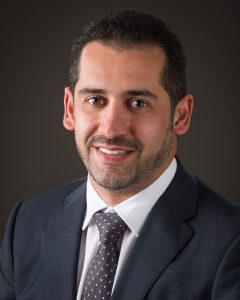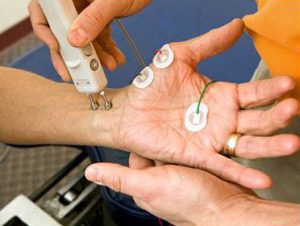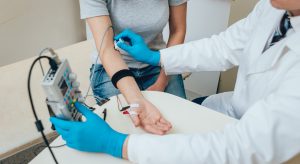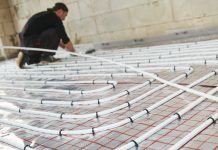Each day in the United States, millions of people suffer with the effects of various peripheral nervous system disorders.

Photo courtesy: PeaceHealth
Many of these conditions, which range from carpel tunnel syndrome to amyotrophic lateral sclerosis (known as ALS or Lou Gehrig’s disease), can be diagnosed through electromyography (EMG) and nerve conduction testing.
EMG testing looks at electrical signals that muscles make when at rest and in use, while nerve conduction studies measure how fast and how well the body’s electrical signals travel down nerve pathways. Together, the tests are used by neurologists to help determine if a patient has a nerve disorder, muscle disorder, or both.
Doctor Seyedali Hejazi, a neurologist who joined PeaceHealth this year following a two-year fellowship at UCLA specializing in adult epilepsy, says recent wait times for EMG and nerve conduction tests at local PeaceHealth facilities have greatly improved.
Waiting four to five months to receive testing was not uncommon, but with testing now occurring at PeaceHealth Medical Group clinics in Bellingham and Sedro-Woolley wait times are typically less than five weeks, Hejazi says. Urgent patients can usually be seen in under a week, he adds.
Generally, patients who receive these tests present with continued weakness, numbness or loss of function in a limb, with possible pain accompanying these symptoms. Like with many medical specialties, testing is usually suggested after a referral to a neurologist, either from a patient’s primary care physician or orthopedic doctor, depending upon the patient’s issues.
It’s important to note that these tests are generally not for those with acute issues. Sudden onset of one-sided numbness or weakness is a sign of stroke and should be dealt with immediately by calling 9-1-1 and going to an emergency room.
Although each test is different, both involve the observation of electrical signals.

“For EMG, we stick a small, acupuncture-size needle into different muscles, and listen to the electrical activity of the muscles and the patterns of muscle fibers,” Hejazi says. “For nerve conduction, we deliver some electrical pulse or shock to the nerves, and then we either record from the same nerve—a sensory nerve—or if it’s a motor nerve, we record from a muscle stimulated by that particular nerve.”
The tests are administered by either a technician or the neurologist who also evaluates the results. For both tests, a patient enters a testing room and lies on a bed next to the testing equipment.
For nerve conduction tests, electrodes are applied with tape onto the patient’s hands or feet in areas along the nerve pathway. The testing practitioner then uses an electric probe attached to the machine to induce electrical stimulation or shocks. When the electrical stimulus excites a nerve, the signal travels the length of the nerve fiber to the muscle. The machine records how fast and strong the response to the signal is, and if anything is delaying or blocking that signal.

If the nerve conduction test is being used to look for a neuromuscular issue, a specific nerve conduction test called a repetitive nerve stimulation test is used, Hejazi says. Usually, one upper limb and one lower limb will be tested, with both tests taking about an hour, he adds. Nerve conduction tests usually take about 30 minutes, with EMG testing taking around 15 to 20 minutes.
In most cases, patients receive their test results and an explanation of what they mean within 24 hours. The results and explanation are provided by the clinician who initially ordered the test, for example, the patient’s primary care provider, neurologist or orthopedic surgeon.
Conditions diagnosed with support from EMG and nerve conduction tests range from those disorders that originate in the motor neuron cells of the spinal cord to those in the smaller nerves of the fingertips. Among these are ALS, myasthenia gravis, spinal stenosis, muscular dystrophy, pinched nerves in the back or neck, nerve compression, neuropathy from existing health conditions like diabetes and other neuromuscular and inflammatory muscle disorders.
Overall, these tests are a testament to PeaceHealth’s commitment to give patients faster care and more immediate answers to their health concerns.



































